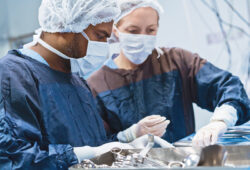A Look Inside AORN’s 2019 Guidelines for Perioperative Practice
When the members of HealthTrust Advisory Boards meet to talk through various products and contracting strategies, they frequently turn to published guidelines from professional healthcare associations to inform their decisions.

“In discussions with clinical advisory board members, we often look to recommendations from the Association of periOperative Registered Nurses (AORN) as our guide to practice, as well as to understand how different members may implement the recommendations,” says Kim Kelly, MSN, RN, HealthTrust’s assistant vice president of clinical operations. “HealthTrust references guidelines for many categories as needed, and we use this information during advisory board calls and meetings and to guide us with contracting recommendations.”

Professional guidelines aren’t just important for HealthTrust’s product vetting and approval process. Kelly adds that these evidence-based positions provide an agreed-upon standard of practice, and they’re usually accompanied by clinical evidence, toolkits, training webinars and recommendations for implementation that take into account variations in practice.
AORN has recently updated its Guidelines for Perioperative Practice, and its 2019 version includes five updated guidelines and one new guideline, according to Lisa Spruce, DNP, RN, CNS-CP, CNOR, ACNS, ACNP, FAAN, and director of evidence-based perioperative practice at AORN. The updated ground rules will not only inform HealthTrust contracts, but they will also likely permeate through healthcare practices across the country.
Spotlight on Specific Changes
The 2019 guidelines include a number of changes that can help ensure safer surgeries for patients and providers. Here are some of the highlights.
1. Sterile Technique
The update to this guideline includes a recommendation to not only cover the sterile field during delays, but also to cover portions of the sterile field that are not in immediate use, Spruce says.
“The importance of covering sterile tables during unanticipated delays and during periods of increased activity is emphasized to minimize potential air contamination of the sterile field, which helps to decrease a patient’s risk of surgical site infection,” she explains.
The guideline also makes the following recommendations:
- Determining the need for physically monitoring the covered sterile field based on individual facility decision.
- Positioning the operating table within the unidirectional ultraclean air delivery system (laminar
air flow). - Wearing a surgical helmet system when exposure to blood
or body fluids is anticipated. - Limiting openings of the operating room (OR) door.
2. Design and Maintenance
This guideline has been restructured. Now, rather than addressing only evidence-based design, construction and maintenance recommendations for all areas within the perioperative setting, it “applies to a wide range of phases involved in creating safe OR spaces,” Spruce says. That includes:
- Rethinking traffic pattern area designations for unrestricted, semi-restricted and restricted areas.
- Following the patient through perioperative care to plan intuitive design that supports better throughput efficiency and patient safety.
- Standardizing maintenance planning for daily operations.
3. Safe Environment of Care
This standard has also been restructured. Rather than addressing only care activities in the OR environment, it “addresses the evidence for mitigating environmental care risks such as distractions, fire safety and staff exposure to hazards,” Spruce says.
The patient and staff risks addressed in this guidance include the following:
- Conducting a preoperative fire risk assessment as a team.
- Taking precautions to reduce the risk for exposure to thermal injuries from patient warming techniques.
- Mitigating staff exposure to waste anesthesia gases and chemicals.
- Minimizing noise and distractions created by personnel as well as equipment and devices.
4. Sterilization
The standard for sterilization has been updated to provide more detailed and evidence-based practices within each step of the sterilization process, including for immediate-use steam sterilization (IUSS), Spruce explains. Important recommendations for the complete sterilization process include the following:
- Following a complete sterilization process to ensure saturated steam under pressure is used to sterilize heat- and moisture-stable items unless otherwise indicated by the device manufacturer.
- Performing sterilization in an area intended, designed and equipped for sterilization processes.
- Monitoring sterilization processes in all areas of the facility where sterilization processes are performed.
5. Transmission-based Precautions
This guideline has a new title for 2019 and covers how to prevent transmission of pathogens. It offers a number of new recommendations that address the following:
- When and how to put on and remove personal protective equipment (PPE), as well as recommended strategies to address barriers and educational opportunities for correct PPE practices.
- Selecting gown and mask types according to task and degree of anticipated exposure.
- Wearing PPE during patient transport activities.
- Requiring visitors to wear PPE when visiting patients who require transmission-based precautions.
6. Safe Patient Handling and Movement
The evidence for safe handling and movement of patients is addressed by this new guideline, covering topics such as culture of safety, ergonomic design and practices, patient assessment, competence, and product selection tailored to perioperative patients and team members.
The guideline includes eight recommendations for safe patient handling and movement, as well as seven ergonomic tools to help with decision-making in specific perioperative scenarios. “These ergonomic tools should be applied in daily practice to keep staff safe as well,” Spruce adds.
The recommendations include:
- Lateral transfer of a patient from a stretcher to an OR bed.
- Lifting and holding the patient’s legs, arms and head while prepping.
- Solutions for prolonged standing.
- Tissue retraction.
- Lifting and carrying supplies and equipment.
- Pushing, pulling and moving equipment on wheels.
As new evidence is published about the most effective approaches, standards and best practices will continue to evolve. That’s why practitioners and facility professionals should regularly review updated guidelines to ensure that their techniques and equipment are still appropriate.
“All of the guidelines are important to help perioperative professionals provide safe and high quality care to patients,” Spruce says. “AORN supports perioperative practice by critically appraising and synthesizing evidence and making recommendations that enhance team decision-making rather than a one-size-fits-all approach. This ensures that our guidelines are relevant to individual patient encounters.”
Share Email Compliance, Patient Experience, Q1 2019, Surgery





